How to keep deer from eating your flowers — Cagney’s student essay
How To Keep Deer From Eating Your Flowers
Deers are one of the many animals I commonly find in my backyard as an Alaskan. From gardens, the highway, and even the brush near the local grocery store, deers are all over my small town of Juneau looking for plants to eat. However, according to news articles from across the United States, deer are also known for intruding not only into people’s gardens but cemeteries, floral shops, and really anywhere where they can find flowers to satisfy their hunger (Sangitini, 2014; CBS Pittsburgh, 2015). Because of this, green-thumbed individuals are looking for ways to keep deer out of their plants. The most common approaches to keep deer from eating your flowers are using homemade repellents, adjusting the landscape, and installing deer fences and caging. It is important to note that each method has its own advantages and disadvantages, as well as its own success rate as it depends on the time of year, the grazing habits of the animals in the area, and more.
Deers are deterred by strong scents and flavors (“50 Deer,” 2013), so homemade deer repellents are often formulated from a variety of organic substances and/or household items, such as essential oils, vinegar, soaps, and dryer sheets (Teegarden, 2020).
An example of a natural deer repellent is one made from “10-20 drops of cinnamon, clove, and mint essential oils in a bottle of water with one cup [of] vinegar, a tablespoon of light cooking oil, and a teaspoon of dish detergent” (Teegarden, 2020, p. 16). The oils are pungent and allow the scents to better adhere to the plant surfaces (Teegarden, 2020).
Other individuals have reported that raw egg is another successful deer repellent that you can spray on your flowers (Morris, 2015). Morris states that this method should last for approximately 30 days before needing to spray again. This organic route is perhaps the most simple, cost-efficient, and healthy for the environment.
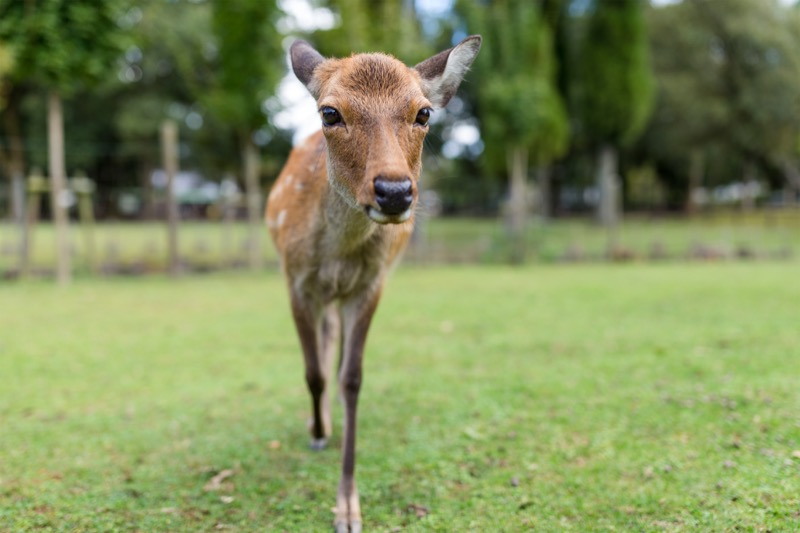
The human scents of these household items are what draws deer away. When using items such as soap and dryer sheets, individuals often cut these products into strips and tie them to branches or lay them close to the plants and trees (Teegarden, 2020). Of course, this technique becomes much more tedious if you have a large garden space. Tossing chunks of bar soap directly onto the ground is another similar method. Teegarden notes that the soap will “eventually dissolve in the rain and have to be replaced” (p. 16). Vandenburg-Ohms (2007) claims that their staff has had success with such homemade repellents.
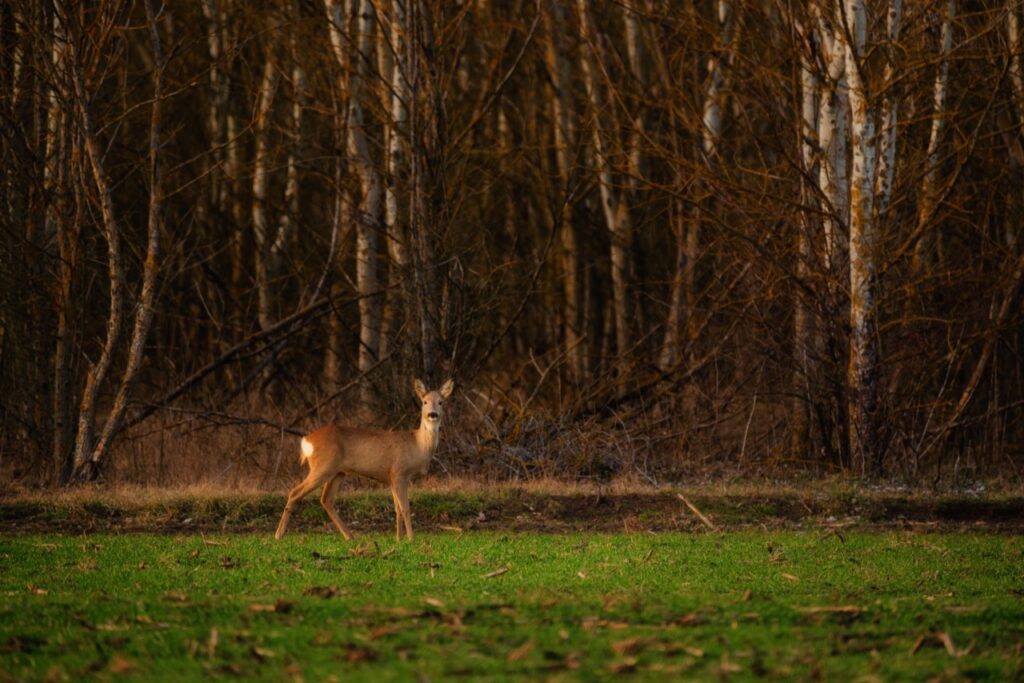
While utilizing foul-smells is an accessible method, another system to keep deer away from your flora is simply manipulating the landscape. Deers are not fond of plants that are “prickly, aromatic, fuzzy, or have natural poisons” so choosing flowers that fit those characteristics are one way to keep these creatures out of your garden (Stratton, 2019, p. 23). Many gardeners have interplanted such flowers among those that are likely to get eaten so it confuses the deer (Vandenburg-Ohms, 2007).
Another tactic if you have a large space, is to create a “sacrificial garden” (Teegarden, 2020, p. 16). A sacrificial garden, or forager garden, is a second garden near the woods or on a property line in an “area convenient for wild animals to forage safely without going directly to your main garden” (Teegarden, 2020, p.16).
When taking this approach, remember to use care when planting potentially poisonous plants around pets and children. It is also rather significant to know, however, that deer from different areas vary in taste buds, and that if these deer are incredibly hungry due to harsh weather conditions, it is also possible that they may adapt to such flowers just to satisfy their hunger (Stratton, 2019).
Many individuals use deer fences and caging to ultimately protect their flowers and crops. Nakahama et al. (2020) stated that deer fences are “an effective method for biodiversity conservation” (p. 2201). Such fences are often used to keep these wild animals out of plants and keep them from further causing damage to the ecosystem. Deer fences and caging involves the use of netting to frustrate deer and in turn drive them away (Teegarden, 2020).
Some individuals simply use trunk collars or even large pool noodles to protect their gardens (Teegarden, 2020). Vandenburg-Ohms (2007) suggests that the most effective deer fence for enclosing your property is one that is at least 8 feet high. There are various types of deer fences and caging such as taste repellents and odor repellents, which are similar to the methods mentioned in the previous paragraphs where contact and area play a role in deterring deer (Takiff, 2016). Mechanical deer fences use scare tactics to drive away deer by water, ultrasonic alarm, lights, and slight electric shocks (Takiff, 2016). Although this approach is more invasive, these fences and caging appear to be the most effective in conserving plants from deer (Nakahama, 2020).
As intriguing as it is to spot a deer, many prefer that they stay away from our flowers and gardens. To do so, individuals can find products from around their home and create their own repellents, change up the landscaping, or install a deer fence to keep deer from eating their plants. Each of these methods play on the characteristics that deer are not fond of strong smells and flavors, spiky textures, dull colors, poisonous plants, and surprising motions. Whichever strategy you choose, do make sure to think about which approach is best for you.
Author: Cagney Ramirez
University of Alaska Southeast
References
References
CBS Pittsburgh. (2015). 2 Deer Cause Thousands Of Dollars In Damage At Flower Shop. Retrieved July 19, 2020, from https://pittsburgh.cbslocal.com/2015/07/03/2-
deer-cause-thousands-of-dollars-in-damage-at-flower-shop/.
DeGroote, L. W., Ober, H. K., Aldrich, J. H., Norcini, J. G., & Knox, G. W. (2011). Susceptibility of cultivated native wildflowers to deer damage. Southeastern Naturalist, 10(4), 761.
Morris, J. (2015). A little egg and water will keep deer out of flowers. Contra Costa Times (Walnut Creek, CA), p. 2A. Available from NewsBank: Access World News – Historical and Current: https://infoweb-newsbank-com.ezproxy.uas.alaska.edu/apps/news/document
-view?p=WORLDNEWS&docref=news/156CBFFBD1CDDC80.
Nakahama, N., Uchida, K., Koyama, A., Iwasaki, T., Ozeki, M., & Suka, T. (2020). Construction of deer fences restores the diversity of butterflies and bumblebees as well as flowering plants in semi-natural grassland. Biodiversity & Conservation, 29(7), 2201–2215. https://doi.org/10.1007/s10531-020-01969-9
Sanginiti, T. (2014). With deer eating fresh flowers, cemetery turns to fake plants. Retrieved July 19, 2020, from https://www.delawareonline.com/story/news/local/2014/04/09/deer-
eating-fresh-flowers-cemetery-turns-fake-plants/7509483/.
Stratton, A. E. (2019). Deer-resistant beauty. This Old House, 24(3), 23–25.
Takiff Philadelphia Daily News, B. (2016). New gadgets for plant lovers – Deer fence, weeder powered by water at Flower Show. GARDENING. Dayton Daily News (OH), p. D6. Available from NewsBank: Access World News – Historical and Current: https://infoweb-newsbank-com.ezproxy.uas.alaska.edu/apps/news/document-view?p=WORLDNEWS&docref=news/15D4A6B905F4B050.
Teegarden, M. (2020). How to make homemade deer repellent. Countryside & Small Stock Journal, 104(3), 16.
Vandenberg-Ohms, J. A. (2007). Deer proofing your garden. Garden & Greenhouse, 5(2), 20–22.
50 Deer resistant flowers, plants and herbs. (2013). Mankato Examiner (MN). Available from NewsBank: Access World News – Historical and Current: https://infoweb-newsbank-
com.ezproxy.uas.alaska.edu/apps/news/document-view?p=WORLDNEWS&docref=news/145EE38C396D81F0.

Student Scholarships
Every year Thrive Pest Control hosts an essay contest and the reward is a 1-year scholarship at a 4-year university in the United States. This blog post is one of those scholarships.

How to Pick a Pest Control Company — Aiden’s Student Essay
Home is where you feel safe, secure, and where you live your life. Not only is your house a home to you, but it is also the home to the years of memories you have made there
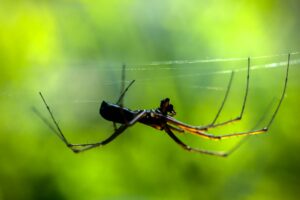
Which spiders in the U.S. are venomous? — Gabriela’s Student Essay
Which Spiders in The U.S Are Venomous? There are three popular and known poisonous spiders in the United States – the black widow, the hobo,
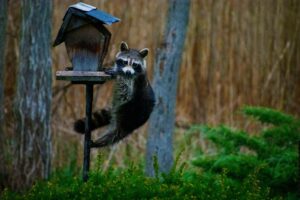
Signs of raccoons terrorizing your home — Denver’s student essay
Signs of Raccoons Terrorizing Your Home “What’s that scratching noise I’m hearing in my attic?” “Why are my garbage bins knocked down every morning?” “Where
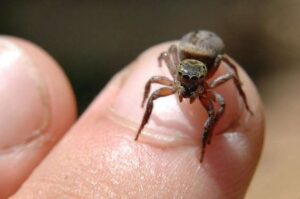
Will Pest Control Get Rid of Spiders — Joe’s student essay
Will Pest Control Get Rid of Spiders? When asked if pest control gets rid of spiders most people’s immediate answer would be, “I don’t know,

Where does pest control spray in apartments — Sarahi’s student essay
Where Does Pest Control Spray In Apartments? When the situation involves bugs, rodents, and even insects, there can be a variety of places where pest

Where does pest control spray in apartments — Aidan’s student essay
Where Does Pest Control Spray In Apartments? The home exists as a place of comfort and safety. The best option for financially independent young adults
